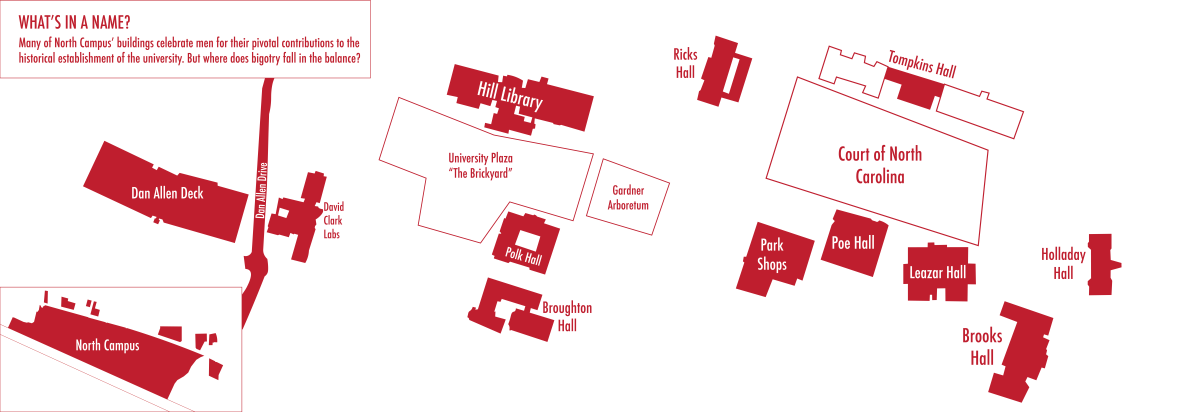Many of North Campus’ buildings celebrate men for their pivotal contributions to the historical establishment of the university. But where does bigotry fall in the balance?
Tompkins Hall
Tompkins Hall is named for Daniel Tompkins, an industrialist who was pivotal in the creation of a textile school at the University. The building originally housed the textile department, and Tompkins was the original designer of the building. Tompkins also argued against abolition, integration, civil rights and child labor laws. He voiced these views in the Charlotte Observer, where he was part-owner, and used this platform to aid a statewide white supremacist campaign in the late-19th century.
Poe Hall
Poe Hall was named for Clarence Hamilton Poe in its 1971 dedication. Poe served as the chair of the Board of Trustees Executive Committee and was well-known for his agricultural work, especially as the editor of the Progressive Farmer. In this role, he also advocated for the segregation of rural North Carolina and sought to diminish opportunities for Black farmers. In an article entitled “Which is the Handicapped Race?” he argued African Americans “made no important contribution to civilization.”
Holladay Hall
Holladay Hall was NC State’s first building on campus and was named for Alexander Holladay, the University’s first president. Holladay helped transform the University from a plot of land into a professional institution of education. He also served as a colonel in the Confederate Army. Josephus Daniels wrote of him, “The best type of the real Southern Christian gentleman.”
Park Shops
Park Shops was named for Charles Park, who taught engineering and industrial mechanical arts in the building for over 40 years. Park was also the first vice president of Raleigh’s White Supremacy Club. With this group, Park helped pass a state constitutional amendment requiring a poll tax and literacy test intended to disenfranchise Black voters.
Dan Allen
Dan Allen Drive and parking deck commemorate Daniel Allen, a prominent Raleigh realtor who graduated from NC State and briefly served on the University’s Board of Trustees. Allen was well-known for his philanthropy and had the road dedicated to him in 1940. Allen was the secretary of Raleigh’s White Supremacy Club and actively participated in the violent repression of Black voters in the 1900 election.
Brooks Hall
Brooks Hall was named for the University’s fifth president, Eugene Brooks, in 1956. Brooks was an influential figure in the expansion of state education, both for Black and white North Carolinians. As president, he oversaw the organization of schools — now colleges — and steered the University through part of the Great Depression. Brooks also advocated for segregation, and he published a children’s book that said enslaved African Americans could not be free because their “semi-savage state” would threaten the happiness of the white race.
Polk Hall
Polk Hall was named for Leonidas Lafayette Polk in 1926. Polk was integral to the early 19th century lobbying effort that sought to establish an agricultural college using land grant funds. He founded the Progressive Farmer and was an influential figure in state agriculture development. Polk was a slave owner and served as a colonel for the Confederacy in the Civil War. He called emancipation and the constitutional amendments guaranteeing formerly enslaved people rights “the greatest crime of modern times.”
D.H. Hill Jr. Library
D.H. Hill Jr. Library was dedicated to Daniel Harvey Hill Jr. at the library’s opening ceremony in 1955. Hill was renowned for his scholarly reputation, serving as the University’s first librarian and eventually its third president. Hill was a proponent of the Lost Cause, which frames the Confederate Civil War effort as justified and ignores the social implications of slavery. His books on the war state North Carolinians should be proud of their efforts and laud the individual achievements of Confederate soldiers.
Ricks Hall
Ricks Hall is named for Robert Henry Ricks, a successful farmer who helped introduce popular tobacco strains to North Carolina. Ricks served as a member of the 1903 General Assembly, which provided appropriations for much of the early development of the University, and he was one of the first members of the Board of Trustees. Ricks was also a Confederate veteran and funded a large marble statue commemorating fallen Confederate soldiers in Rocky Mount, North Carolina.
Broughton Hall
Broughton Hall was named for Joseph Melville Broughton, who served as North Carolina’s 60th governor and as a U.S. senator. He was the first president of NC State’s Engineering Foundation and first incorporated a supplemental private support program for the University’s budget. Though he advocated for the advancement of Black North Carolinians in several respects, he was a staunch segregationist who believed “in a policy of purity” and refuted the effects of racism in his administration.
Leazar Hall
Leazar Hall is named for Augustus Leazar, who served as the speaker of the North Carolina House of Representatives in 1889. Leazar co-authored, introduced and oversaw the passage of the original bill to establish the North Carolina Agricultural and Mechanic College in 1887; the college opened in 1889. He was also a first lieutenant in the Confederate Army.
David Clark Labs
David Clark Labs was formerly named Mangum Hall and was renamed to honor David Clark in 1963. Clark was influential in the development of the School of Textiles, whose chemistry department and research facilities were originally located in the building. Clark was an outspoken white supremacist and antisemite who frequently voiced these prejudices toward students and faculty. He was so vocal about these views that NC State’s student legislature attempted to have him removed from the Board of Trustees in 1952.








